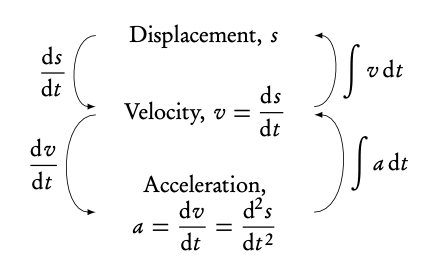4.5.1 Kinematics
Kinematics deals with the movement of bodies over time. When you are given one function to calculate displacement, velocity or acceleration you can use differentiation or integration to determine the functions for the other two.

The derivative represents the rate of change, i.e. the gradient of a graph. So, velocity is the rate of change in displacement and acceleration is the rate of change in velocity.
Answering kinematics questions.
- Find an equation for velocity by differentiating equation for distance
v(t) = −9.8t + 4.9
2. Solve for v(t) = 0
−9.8t + 4.9 = 0, t = 0.5
3. Put value into equation for distance to find height above water
4.5.2 Optimization
We can use differentiation to find minimum and maximum areas/volumes of various shapes. Often the key skill with these questions is to find an expression using simple geometric formulas and rearranging in order to differentiate.
Finding the minimum/maximum area or volume
The sum of height and base of a triangle is 40 cm. Find an expression for its area in terms of x, its base length. Hence find its maximum area.
- Find expressions for relevant dimensions of the shape
length of the base (b) = x
height + base = 40
so h + x = 40
area of triangle A= ½ xh
2. Reduce the number of variables by solving the simultaneous equations
Since h = 40 − x , substitute h into A:
A = ½ x(40 − x) =−½ x2 + 20x
3. Differentiate
f ′(x) = −x + 20
4. Find x when f ′(x) = 0
−x + 20 = 0 ⇒ x = 20
5. Plug x value in f (x)
−½ 202 + 20(20) = −200 + 400 = 200cm2
Note: If an expression is given in the problem, skip to step 2 (e.g. cost/profit problems)
